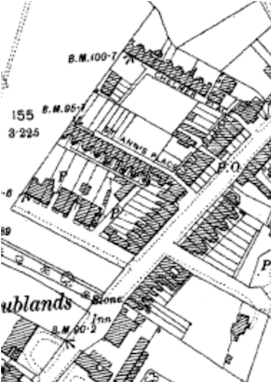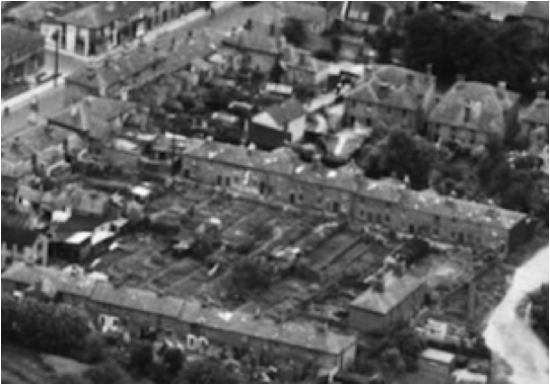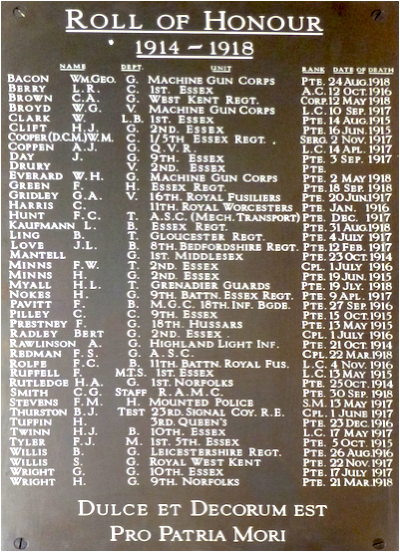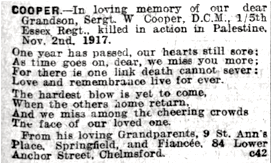William John Martin Cooper although born in London was brought up by his grandparents in Springfield. After working at Hoffmann’s he joined the army as a Territorial in 1912 and saw service fighting the Turks in Gallipoli and the Middle East. He was awarded the Distinguished Conduct Medal for gallantry at the First Battle of Gaza in March 1917. Engaged to be married, he died from wounds at the Third Battle of Gaza in November 1917. His home was in St. Ann’s Place.
William was born in Euston, London on 13th February 1896, the son of William Louis Cooper and Sarah Ann Cooper (formerly Simmons). The couple had married in London in 1895. He had at least three London=born younger brothers. He was baptised at All Saints’ Church, Springfield on 5th April 1896 at which time his parents were living in Springfield where William’’s father was a postman.
His mother’s mother was born Susan Elizabeth Willlingham, and married firstly to his grandfather John Simmons (1839-1875) and then to John Martin Linnett (1838-1924). As a young child William went to live with Susan Elizabeth and John Martin Linnett.
COOPER, WILLIAM JOHN MARTIN, Distinguished Conduct Medal,
Sergeant, 1/5th Battalion, Essex Regiment
Company were in reserve while comrades from the 1/6th and 1/7th Battalions of the Essex Regiment were to assault other Turkish positions in the area, including Beach Post, Sea Post Cricket redoubt and the Rafa-Belah trench which ran northwards from Rafa Redoubt.
At 4.30 p.m. on 1st November 1917 a short service was held for William’s battalion, which was well attended. Half an hour later the battalion’s troops went to sleep. At 11 p.m. a ‘good square hot meal’ was served with a pint of beer to wash it down, to the accompaniment of an artillery duel began between the Allies and Turks. The bombardment continued until 1 a.m., and by 2.30 a.m. the battalion’s troops were in position for the attacks, timed to start at 2.55 a.m. The battalion consisted of 25 officers and 925 other ranks.
A post-war account of the battalion by its commander continued:
“Silence reigned supreme and we stood unscathed on ground, which an hour before had been a veritable inferno. It was a good start. The tanks had got over safely and at 2.55 the Companies moved off. At three precisely, the artillery commenced. The moon had just disappeared and the light was very bad. The smoke and dust of the fire made a thick fog and the compass had to be relied upon for direction....After about half-an-hour a runner got back to say that the enemy’s front line was in our hands....The Turks had put up a wonderful fight, many of them lying in forward positions in the open to avoid the bombardment, and meeting our men with the bayonet.
Still the reports were very confusing, as both attacking parties claimed to be in the Rafa redoubt. No word was received as to the Zowaid trench. Runners lost their way in the thick haze and it was impossible to tell exactly what the situation was. The air seemed filled with fine sand and smoke, which hung about like a thick ground fog and made it very difficult.
Reports came in from the right that attacks on El Arish Redoubt and El Burj trench had been repulsed. I was very anxious about Zowaid, which joined El Burj. The reports, however, proved incorrect. It was now broad daylight and the enemy was firing furiously from his second line. The 6th [Essex] had taken Beach and Sea Posts with little trouble. The 7th [Essex] had taken Cricket redoubt. bit had not succeeded in their attack on the very important trench the Rafa-Belah. The tanks had broken down and neither had reached even its first objective. The loss of their support was a serious blow for the 7th.
The morning wore on and still no more definite news of Zowaid.”
Over the next few hours news emerged that B Company, whose objective had been Zowaid Trench had lost direction in the darkness and struck Rafa instead - the objective of A and D Companies. A swarm of men from B Company had been spotted by the commander of D Company, Lt. E. B. Deakin, clambering up the steep sandy slope which led up to Rafa Redoubt. Realising the error Lt. Deakin then took his men to attack Zowaid Trench instead which was captured by A and D Companies, who suffered heavy casualties in doing so. Men from C Company also entered Rafa Redoubt, but the Rafa-Belah trench held out and inflicted heavy casualties on the 7th and 10th Battalions of the London Regiment who were fighting nearby. The post-war account continued:
“It [the Rafa-Belah trench] was effectively blocked from the Rafa redoubt end, where [2nd Lt.] Archer did great work with his Lewis gun, fighting it himself almost single-handed after Sergeant C. T. Allaway, his most efficient Lewis gun non-commissioned officer, had been killed and most of the team knocked out. C.-S.-M. Wilson did splendid work in helping to organise and consolidate the position. Richmond and Lockwood, I remember, were conspicuous too, in Rafa redoubt; but it is hardly fair to mention names, there were so many others.”
The battalion managed to reinforce and retain both Rafa Redoubt and Zowaid Trench despite further attacks and heavy artillery fire from the Turks. Writing after the war the battalion’s commander stated:
“The capture of the Rafa redoubt and Zowaid trench was a feat of which the Battalion may well be proud. That the enemy offered a determined resistance was shown by the fact that our casualties in the action were two officers and 73 other ranks killed, seven officers and 172 other ranks wounded and nine other ranks missing. The killed included....such good non-commissioned officers as Sergts. H. Byles, N Bruce and D. Ambrose, Corpl. P Andersen, and L/Corpl. H. Quilter and Tasker.”
Twenty-one year-old William was one of those 73 killed, dying from wounds to his head on the day of the advance. In addition to him a further six men commemorated by the Chelmsford War Memorial were also killed in the attack. They were: Charles Thomas Allaway, Percy Andersen, Stanley William Ellis, Ernest Horrex, Arthur Stanley Tasker and Bertram Harry Wright. Like William, Stanley William Ellis lived at Chelmer Place.

The 1901 census listed five year-old William living at 9 St. Ann’s Place, Springfield a short road off Springfield Road just beyond Meadowside, which was demolished in the 1960s (see map, left and below, an aerial shot taken from the north which shows St. Ann’s Place running left to right across the photograph.
William was accompanied by his grandmother and step-grandfather, and their unmarried children James Thomas Linnett (born on 25th June 1880 in Springfield), Charles Linnett (born on 14th January 1886 in Springfield), and Frances Simmons (born c1869 in Springfield). Meanwhile his parents and three younger siblings were recorded at 82 Palmerston Road in Hampstead, London.
William was recorded by the 1911 census aged 15, working as a washer assembler, and living with his grandparents and two uncles, James and Charles Linnett at 9 St. Ann’s Place. His grandfather was a road surveyor for Chelmsford Borough Council, while his uncles James was a builder’s labourer, and Charles was a tailor. William is known to have worked in Hoffmann’s bearings factory in Chelmsford prior to the war.
William lived in Springfield and enlisted into the army at Chelmsford in 1912 into the 1/5th

Battalion of the Essex Regiment where he served as Private 1487 (later 250106). He was to rise to the rank of sergeant. The battalion was a Territorial unit formed in 1908 with its headquarters in Market Road, Chelmsford, and it naturally contained many Chelmsford men who were to lose their lives in the war.
At the outbreak of the war William’s battalion and three other Essex Territorial battalions which formed the 161st (Essex) Brigade in the 54th (East Anglian) Division had been half-way through their fortnight’s annual training at Clacton. On 3rd August 1914, the day before war was declared, William’s battalion was initially ordered back to Chelmsford, but that was countermanded and the battalion marched for Dovercourt that afternoon where it was alloted part of a pre-arranged defensive line west of the town. On 9th August 1914 the battalion was sent to Brentwood. It did not stay there long, moving to north-east Norfolk by the end of the month, spending much of its time in training in expectation of foreign service and in defence of the eastern counties of England.
In April 1915 his battalion moved to West Bergholt, before transferring to St. Alban’s in Hertfordshire the middle of the following month. From St. Alban’s the battalion travelled to Devonport by train, and departed on board the S.S. Grampian on 23rd July 1915, with a somewhat depleted strength of 29 officers and 649 other ranks. Its ultimate destination was to be Gallipoli, Turkey to join the Allied forces participating in the campaign against the Turks which had started on 25th April 1915.
Stops were made at Malta and Alexandria in Egypt, before sailing to Mudros Bay on the small Greek island of Lemnos. From there the battalion sailed towards Gallipoli, transferred to flat-bottomed boats and its troops including William were put ashore at A Beach, Suvla Bay on 9th August 1915 to supplement forces that had landed there over the previous three days. The 1/5th Battalion of the Essex Regiment had a difficult time in Gallipoli, making little progress against the Turkish Army and suffering heavily from disease.
With the failure of the Gallipoli campaign William’s battalion was withdrawn from Anzac Cove on 4th December 1915; its strength reduced by then to 13 officers and 141 other ranks, of whom six officers and 100 other ranks had served throughout the 17 weeks in Gallipoli.
Following its withdrawal from Gallipoli the battalion landed in Alexandria, Egypt on 17th December 1915. On 28th December 1915 it was sent to El Hamam, Egypt where it formed part of the Western Frontier Force. On 5th March 1916 the battalion left for Mena Camp near Cairo, Egypt, before it was moved eastwards to protect the Suez Canal and its vital supply route, in an area known as the Southern Canal Section, from Turkish attacks across the Sinai Peninsula. The battalion remained there until January 1917.
By early 1917 the Turkish forces that had been threatening Egypt were being steadily driven back across the Sinai Peninsular towards Palestine by the advancing Allies. The 1/5th Battalion of the Essex Regiment spent most of February crossing the Peninsular and by late March 1917 was close to the Palestine town of Gaza, then still held by the Turks. The town was of strategic importance and had to be captured by the Allies if they were to succeed in their objective of driving the Turkish army northwards out of Palestine and thus isolating other Turkish forces in Mesopotamia and the Arabian Peninsular.
The initial attack to capture Gaza, known as the First Battle of Gaza, began early on 26th March 1917. The 161st Brigade, including the 1/5th Battalion of the Essex Regiment captured a hill known as Green Hill south-west of Ali el Muntar on the southern outskirts of Gaza. It was done so at a price - the Commonwealth War Graves Commission lists 117 fatalities for the battalion on 26th March 1917 plus 113 in the 1/4th Battalion of the Essex Regiment. Among them were ten Chelmsford men. The heavy casualties were mainly caused by the steady fire of three Turkish machine guns and one automatic rifle, aided by their protected position and perfect lateral filed for cross fire. Those losses were made more bitter by the decision, based on poor intelligence and communications, to withdraw Allied forces from their captured positions that night when in reality the town was their for the taking.
Later, on 16th August 1917 the Supplement to the London Gazette announced the award of the Distinguished Conduct Medal to William at the First Battle of Gaza:
“For conspicuous gallantry and devotion to duty, He reorganised and took over command of his company when all its officers and the company serjeant-major had been put out of action.”
On 17th April 1917 a second attempt to capture Gaza, by then heavily reinforced by the Turks, was started by the Allies. William’s battalion participated in the action. Some progress was made despite determined opposition and heavy casualties (many suffered by the Norfolk Regiment), but the breakthrough the Allies needed could not be achieved and Gaza remained in Turkish hands. The town would not fall to the Allies until 7th November 1917 at the conclusion of the Third Battle of Gaza.
During the period between the Second and Third Battles of Gaza the 1/5th Battalion of the Essex Regiment spent much of its time in trenches facing Turkish forces near to Gaza and the Mediterranean Sea.
On the morning of 1st November 1917 the battalion received news that it was to launch an attack towards Gaza in the early hours of the following morning. The attack was planned as part of a deception designed to convince the Turks that a major assault would be made direct on Gaza, while the main Allied advance was in fact taking place some 30 miles to the east near Beersheba. From Beersheba the Allies would strike westwards towards the coast, threatening to encircle Gaza.
A and D Companies of William’s battalion were to attack the Rafa Redoubt. B Company, and two platoons of C Company were to take Zowaid Trench which lay immediately to the south (and to its right from the battalion’s starting position). Tanks would support both assaults. The remainder of C

As hoped for, the day’s attack by William’s battalion succeeded in not only capturing the Turkish positions it also achieved its strategic objective, which was to keep the Turkish forces tied to Gaza and to draw a large number of troops to reinforce the defence of the town. Allied forces were to continue to advance from the east and on 7th November the Turks abandoned Gaza and retreated to the north.
Today William lies at Gaza War Cemetery in Israel (grave: XXIX. E. 13). Nearby are the graves of seven of his Chelmsford comrades killed in fighting around Gaza in 1917.
On 30th November 1917 the Essex County Chronicle included the following family announcement:
“Cooper. - Killed in action in Palestine, on November 2nd, Sergt. William Cooper, Essex Regt., adopted son of Mr. and Mrs. Linnett, St Ann’s Place, Springfield, Chelmsford,aged 21 years.”
The same edition also reported:
“Sergt. William Cooper, Essex Regt., who was killed in action in Palestine on November 2, was the adopted son of Mr. and Mrs. Linnett, of St. Anne’s Place, Springfield. He went on active service abroad in July, 1915, and had not been home since. Sergt. Cooper won the D.C.M. in March last for conspicuous bravery at the battle of Gaza. He was only 21 years of age, and was employed by the Hoffmann Manufacturing Co. before he enlisted. He was very well-known in Chelmsford, being interested in football, swimming and boxing.”
On 7th December 1917 the Essex Weekly News reported:
“Springfield men reported killed include Sergt. Percy Anderson, Essex Regt., son of Mr. and Mrs. Anderson, Chelmer-place; Sergt. W. Cooper D.C.M., adopted son of Mrs. Linnett, of St. Ann’s-place; Pte. Stanley W. Ellis, Essex Regt., son of Mr. and Mrs. W. Ells, Chelmer-place; and Pte. F. C. Hunt, A.S.C., Mechanical Transport, son of Mrs. Palmer, Gainsborough-cres., killed in an accident in France.”
On 22nd February 1918 the Essex County Chronicle reported:
“Mr. and Mrs. J. Linnett, of 9 St. Ann’s Place, Springfield, have received particulars of the death of their grandson, Sergt. Wm. Cooper, of the Essex Regt., who was killed in action in Palestine on Nov. 2, 1917. He was 21 years of age. Pt. C. W. Challis of the same Regiment and Company, writing to Mr. Linnett, says: “The whole Battalion, and especially his platoon, thought a great deal of him both as a good fellow and as a soldier; his resource. courage, and fearlessness inspired absolute confidence”, Capt. G. H. Willmott, commanding deceased’s company, wrote: “I cannot tell you how deeply I regret the loss of your grandson, Sgt. W. Cooper, who died after a most brilliant career. He distinguished himself on March 26 last. and was doing brilliant work in an attack our battalion were making on Nov. 2. He was wounded in the head during the advance but continued to carry on, and died just before we reached the enemy’s front trenches. He was one of the very best of men and one of the best N.C.O’s in the company. He was given command of a platoon and he was killed while leading it’.”

William is commemorated on the Civic Centre Memorial, Chelmsford, on the Springfield Parish Memorial at All Saints’ Church and on the Hoffmann Manufacturing Company’s War Memorial at Chelmsford Cathedral. In addition to his Distinguished Conduct Medal William was also entitled to the 1914-15 Star, British War Medal, and Victory Medal.
The 1918 register of electors listed William’s grandparents still at 9 St. Ann’s Place, Springfield. His grandmother died in1919; his step-grandfather five years later.
140427